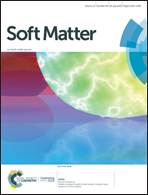Designed self-assembly of metamaterial split-ring colloidal particles in nematic liquid crystals
Abstract
The fabrication of orientationally and positionally ordered colloidal clusters is of interest to several fields from materials science to photonics. An interesting possibility to obtain such colloidal crystalline structures is by the self-assembly of colloidal particles in a liquid crystal matrix. This work demonstrates the self-assembly in a nematic liquid crystal of a specific type of colloidal particle, split ring resonators (SRRs), which are well known in the field of photonic metamaterials and chosen for their ability to obtain resonances in response to a magnetic field. Using free energy minimisation calculations, we specifically optimise geometrical parameters of the SRR particles to reduce and prevent formation of irregular metastable colloidal states, which in more general view corresponds to concepts of pre-designed self-assembly. Using the pre-designed particles, we then show self-assembly into two- and three-dimensional nematic colloidal crystals of split-ring particles. Our work is a contribution to the development of designed large-scale colloidal crystals, the properties of which could be finely tuned with external parameters, and are of high interest for photonic applications, specifically as tunable metamaterials.



 Please wait while we load your content...
Please wait while we load your content...